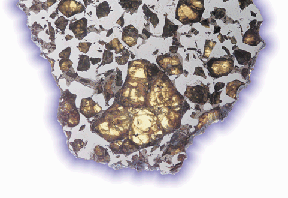Precious gems
It hurtled
toward Earth for eons carrying olivine and an iron-nickel alloy. Then
four months ago, this rock tore through the atmosphere at thousands of
miles an hour before smacking into the mountains near Glorieta, N.M.
The sliced
and polished surface resembles old linoleum, but this speckley specimen
is a pallasite meteorite from the asteroid belt between Mars and Jupiter.
Now it resides
at TCU with more than 1,000 other space rocks in the Oscar Monnig Meteorite
Collection, which has been studied by university geologists since the
Fort Worth businessman donated them in 1980s.
This winter,
the university will showcase the extraterrestrial gems -- most come from
our solar system's asteroid belt plus a rare few from the moon and Mars
-- in a new 1,700-square-foot museum off the second-floor lobby of the
Sid W. Richardson Building.
"We
have a very modern collection with valuable Martian and lunar samples,"
says Dr. Art Ehlmann, emeritus professor of geology and the museum's curator.
"We definitely have the largest collection of meteorites found in
Texas."
In addition
to providing educational and academic opportunities to students across
North Texas, the gallery should become a Cowtown tourist attraction and
enhance the TCU geology department's already "stellar" reputation.
The gallery
opens in January.

Top
|



